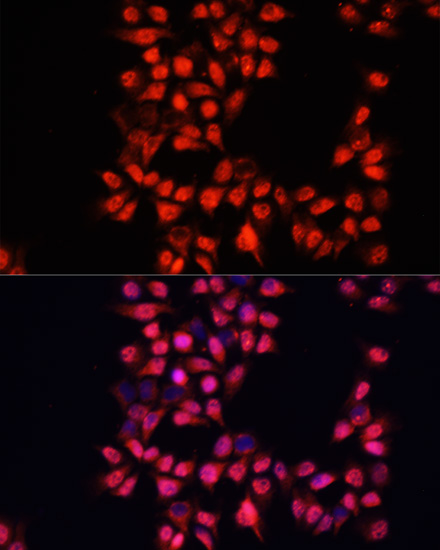Signal Transduction Antibodies 1
Anti-ADAM10 Antibody (CAB10438)
- SKU:
- CAB10438
- Product Type:
- Antibody
- Reactivity:
- Human
- Reactivity:
- Mouse
- Reactivity:
- Rat
- Host Species:
- Rabbit
- Isotype:
- IgG
- Antibody Type:
- Polyclonal Antibody
- Research Area:
- Signal Transduction
Description
| Antibody Name: | Anti-ADAM10 Antibody |
| Antibody SKU: | CAB10438 |
| Antibody Size: | 20uL, 50uL, 100uL |
| Application: | WB IF |
| Reactivity: | Human, Mouse, Rat |
| Host Species: | Rabbit |
| Immunogen: | Recombinant fusion protein containing a sequence corresponding to amino acids 214-500 of human ADAM10 (NP_001101.1). |
| Application: | WB IF |
| Recommended Dilution: | WB 1:500 - 1:2000 IF 1:50 - 1:200 |
| Reactivity: | Human, Mouse, Rat |
| Positive Samples: | HT-1080, Raji, Jurkat, Mouse kidney, Mouse brain |
| Immunogen: | Recombinant fusion protein containing a sequence corresponding to amino acids 214-500 of human ADAM10 (NP_001101.1). |
| Purification Method: | Affinity purification |
| Storage Buffer: | Store at -20'C. Avoid freeze / thaw cycles. Buffer: PBS with 0.02% sodium azide, 50% glycerol, pH7.3. |
| Isotype: | IgG |
| Sequence: | TTSA EKNT CQLY IQTD HLFF KYYG TREA VIAQ ISSH VKAI DTIY QTTD FSGI RNIS FMVK RIRI NTTA DEKD PTNP FRFP NIGV EKFL ELNS EQNH DDYC LAYV FTDR DFDD GVLG LAWV GAPS GSSG GICE KSKL YSDG KKKS LNTG IITV QNYG SHVP PKVS HITF AHEV GHNF GSPH DSGT ECTP GESK NLGQ KENG NYIM YARA TSGD KLNN NKFS LCSI RNIS QVLE KKRN NCFV ESGQ PICG NGMV EQGE ECDC GYSD QCKD ECCF DANQ PEGR KCKL KPG |
| Gene ID: | 102 |
| Uniprot: | O14672 |
| Cellular Location: | Cell membrane, Endomembrane system, Single-pass type I membrane protein |
| Calculated MW: | 49kDa/84kDa |
| Observed MW: | 70kDa/105kDa |
| Synonyms: | ADAM10, AD10, AD18, CD156c, CDw156, HsT18717, MADM, RAK, kuz |
| Background: | Members of the ADAM family are cell surface proteins with a unique structure possessing both potential adhesion and protease domains. This gene encodes and ADAM family member that cleaves many proteins including TNF-alpha and E-cadherin. Alternate splicing results in multiple transcript variants encoding different proteins that may undergo similar processing. |
| UniProt Protein Function: | ADAM10: Cleaves the membrane-bound precursor of TNF-alpha at '76-Ala-|-Val-77' to its mature soluble form. Responsible for the proteolytical release of soluble JAM3 from endothelial cells surface. Responsible for the proteolytic release of several other cell-surface proteins, including heparin-binding epidermal growth- like factor, ephrin-A2 and for constitutive and regulated alpha- secretase cleavage of amyloid precursor protein (APP). Contributes to the normal cleavage of the cellular prion protein. Involved in the cleavage of the adhesion molecule L1 at the cell surface and in released membrane vesicles, suggesting a vesicle-based protease activity. Controls also the proteolytic processing of Notch and mediates lateral inhibition during neurogenesis. Responsible for the FasL ectodomain shedding and for the generation of the remnant ADAM10-processed FasL (FasL APL) transmembrane form. Also cleaves the ectodomain of the integral membrane proteins CORIN and ITM2B. May regulate the EFNA5-EPHA3 signaling. |
| UniProt Protein Details: | Protein type:Cell adhesion; Cell surface; EC 3.4.24.81; Membrane protein, integral; Motility/polarity/chemotaxis; Protease; Vesicle Chromosomal Location of Human Ortholog: 15q21.3 Cellular Component: cell surface; cytoplasm; focal adhesion; Golgi apparatus; Golgi-associated vesicle; membrane; nucleus; plasma membrane Molecular Function:endopeptidase activity; metalloendopeptidase activity; metallopeptidase activity; protein binding; protein homodimerization activity; protein kinase binding Biological Process: constitutive protein ectodomain proteolysis; ephrin receptor signaling pathway; extracellular matrix disassembly; in utero embryonic development; membrane protein ectodomain proteolysis; monocyte activation; negative regulation of cell adhesion; neutrophil degranulation; Notch receptor processing; Notch signaling pathway; PMA-inducible membrane protein ectodomain proteolysis; positive regulation of cell growth; positive regulation of cell migration; positive regulation of cell proliferation; protein amino acid phosphorylation Disease: Alzheimer Disease 18; Reticulate Acropigmentation Of Kitamura |
| NCBI Summary: | Members of the ADAM family are cell surface proteins with a unique structure possessing both potential adhesion and protease domains. This gene encodes and ADAM family member that cleaves many proteins including TNF-alpha and E-cadherin. Alternate splicing results in multiple transcript variants encoding different proteins that may undergo similar processing. [provided by RefSeq, Feb 2016] |
| UniProt Code: | O14672 |
| NCBI GenInfo Identifier: | 29337031 |
| NCBI Gene ID: | 102 |
| NCBI Accession: | O14672.1 |
| UniProt Secondary Accession: | O14672,Q10742, Q92650, B4DU28, |
| UniProt Related Accession: | O14672 |
| Molecular Weight: | 84kDa |
| NCBI Full Name: | Disintegrin and metalloproteinase domain-containing protein 10 |
| NCBI Synonym Full Names: | ADAM metallopeptidase domain 10 |
| NCBI Official Symbol: | ADAM10 |
| NCBI Official Synonym Symbols: | RAK; kuz; AD10; AD18; MADM; CD156c; CDw156; HsT18717 |
| NCBI Protein Information: | disintegrin and metalloproteinase domain-containing protein 10 |
| UniProt Protein Name: | Disintegrin and metalloproteinase domain-containing protein 10 |
| UniProt Synonym Protein Names: | CDw156; Kuzbanian protein homolog; Mammalian disintegrin-metalloprotease; CD_antigen: CD156c |
| Protein Family: | Disintegrin and metalloproteinase domain-containing protein |
| UniProt Gene Name: | ADAM10 |








